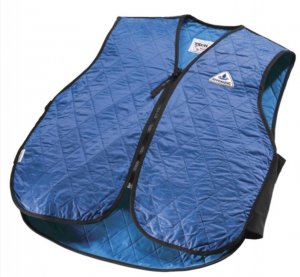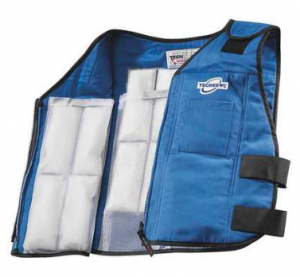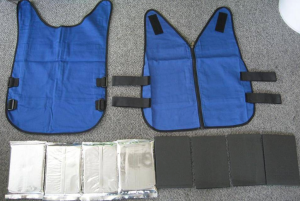There are a variety of personal cooling systems that are available for purchase, and each style has unique advantages and drawbacks. Here is a brief summary of the three most popular systems:
Evaporative Cooling Vest

These vests feel like terry cloth but have tiny pockets of highly absorbable beads that can take in water and expand to 6 times their dry size. The vest is soaked in cool water and gently wrung out to remove excess. The vest is placed over a t-shirt and cools by evaporation; the air moves faster next to the water-logged beads, which creates a layer of cool air between the vest and the skin. Evaporative cooling vests are light weight, inexpensive, and there is no need to purchase a second vest to swap; the vest can be re-wet and immediately used again. Evaporative cooling apparel is not limited to vests; headbands, wristbands, floor mats, and even dog vests are available for purchasing. If an evaporative vest is damaged, it can be re-sewn by hand. The function of the vest isn't seriously compromised if a few beads escape. (The beads are non-toxic, but always check the vest carefully to avoid ingestion by a child.) Evaporative cooling vests are of limited benefit in humid environments and are sometimes not tolerated by individuals with sensitive skin due to the slight dampness of the garment.
Phase Change Cooling Vests

This type of vest contains inserts that are activated by placing them in the freezer or a container of ice water, and then the inserts maintain a consistent temperature (usually 53-56 degreesF.) for up to three hours. The inserts can then be re-activated (10 to 20 minutes for activation) and reused. Many people choose to purchase an extra set of inserts and rotate them, so that the vest can be used continuously. The inserts are not exactly ice packs; they do not reach freezing temperatures so they are unlikely to cause damage if left in contact with bare skin. This makes them safe to use with young children or individuals who are unable to feel heat or cold due to neuropathy or communicate discomfort. They are activated when exposed to temperatures above freezing, and need much less time to recharge than an actual frozen ice pack would take. Also, the inserts do not "sweat" when the cold is being transferred to the wearer, so clothing stays dry. Phase change vests can be made to fit wearers of all ages and sizes, custom vests can be made for individuals weighing more or less than the displayed vests are recommended for.
There are drawbacks to purchasing and using phase change vests. The inserts add weight to the vest, from 1 ½ to 2 lbs for children's vests to 4 lbs or more for 3X or 4X adult sizes. Fortunately, the weight is evenly distributed on the body and is close to the individual's center of gravity, so the balance issues associated with backpacks or weights shouldn't be a problem. The cooling vest system is much more expensive than an evaporative vest; you can expect to pay around $200 for a vest and two sets of inserts. The phase change inserts are filled with a viscous fluid and are durable but not indestructible. If an insert is damaged it must be discarded and replaced.
Hybrid Cooling Vests
This vest combines the benefits of the evaporative as well as phase change vests. The user has the ability to choose between using the evaporative or phase change cooling methods, and can also choose to use both systems simultaneously to complement one another. This type of vest is new to the market, but customers who have purchased hybrid guests have reported high satisfaction rates.
Cold Pack Cooling Vests

These vests look just like phase change cooling vests, but use actual ice packs that freeze at 32 degrees or in some cases, even colder. These cold packs give the highest level of cooling because the cold packs are the lowest temperature. These vests are effective in extreme humidity and very high temperatures. Extra packs can be added or changed out over time.
There are several drawbacks to cold pack vests. The frozen inserts are generally heavier than phase change inserts, are usually inflexible when frozen, and must be returned to an actual freezer, below 32 degrees farenheight, to be refrozen, which can take several hours. Most frozen packs "sweat" while discharging cold energy, which some individuals may find uncomfortable. Most importantly, ice packs cannot be applied directly to skin and should never be used by individuals who may have impaired sensation, are asleep, or unable to communicate discomfort, as frostbite and serious injury can occur.
Websites for purchasing cooling vests:
Heat Relief Depot This company offers a discount to any customer who submits a note from a medical professional stating that the products are purchased for medical reasons. They do make children's phase change cooling vests per special order. Several years ago, they were willing to make a vest for a 20lb toddler. Call for more information.
MScooling This site offers all three vest styles in sizes that range from x-small (20" length from shoulder to waist and 33" torso circ. at the widest point) to xxx-large (25"L, 51"circ)
Texas Cool Vest Phase change vest that is adjustable to fit from 6 y.o. child through small adult
Stacool Vest Phase change vest in 2 children's sizes, $200+
Coolweave Silver Eagle Outfitter's cooling vests
Paying for cooling vests
Cooling vests can be costly, but can dramatically improve the health, safety, and quality of life of an adult or child with Mito. Some cooling vest distributors will offer a 10%-25% discount on their products if they receive documentation that the vest or other products are purchased on a doctor's recommendation. Save your receipt to submit the cost of cooling products towards your federal taxes. Some insurances may accept cooling vests as medical devices and while vendors are unable to submit insurance claims, you may be able to submit a claim yourself and request a refund.
Keeping Cool
Don't forget about your other warm-weather strategies! Be sure to stay hydrated, take frequent breaks when working or playing outside, limit your time outside when the sun is most intense (usually 10am to 2pm), and use sunblock with an spf of 30 or higher and re-apply often. Always contact your doctor for specific suggestions related to heat intolerance management. With a little planning, you and or your child can welcome spring while keeping your cool. Enjoy!











